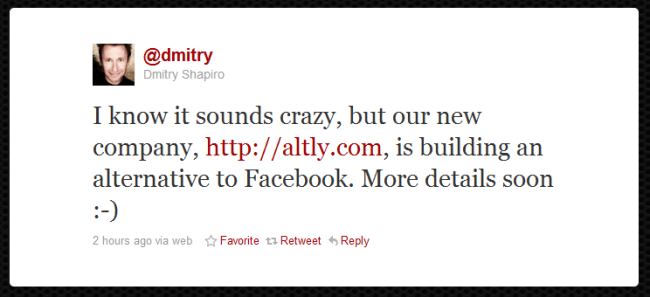 “I know it sounds crazy, but our new company, http://altly.com, is building an alternative to Facebook. More details soon :),” Dmitry Shapiro tweeted this morning. That’s all he had to do to create a stir in digital media. Altly is in the stealthiest of stealth modes: Aside to its CEO’s cryptic tweet, there is nothing to be found about the project.
“I know it sounds crazy, but our new company, http://altly.com, is building an alternative to Facebook. More details soon :),” Dmitry Shapiro tweeted this morning. That’s all he had to do to create a stir in digital media. Altly is in the stealthiest of stealth modes: Aside to its CEO’s cryptic tweet, there is nothing to be found about the project.
In a very Hipster-like move (remember Hipster? That super secret startup from a month or so back that turned out to be created specifically for SXSW and originally featured nothing but scenic images and the word “Hipster” in bold letters? Remember how everyone was curious for, oh, I don’t know…two weeks?), Altly’s site is bare except for this premonition:

Dmitry Shapiro was most recently CTO at MySpace Music. He worked there for a mere 10 months before bailing off that sinking ship on April 15 to begin his own startup, Altly. Prior to MySpace, Shapiro founded video site Veoh. Veoh has an interesting history; on one hand, it was a successful Internet streaming site that provided big studio productions and even had former Disney exec Michael Eisner on its board. It is only available in the US, which was a source of contention, and eventually copyright battles forced the company to file bankruptcy. It’s since been acquired by Israeli startup Qlipso.
And before Veoh, Shapiro founded Akonix Systems, which was later acquired by Quest Software. Akonix provides secure instant messaging and various business communication products at the executive level.
Will Shapiro be able to bring the goods to Altly? Seems a bit ambitious, but we’ll be keeping an eye (more like sideways glance) on the site.
